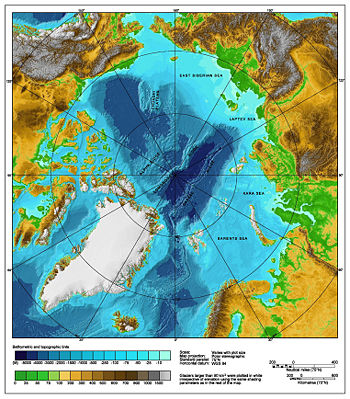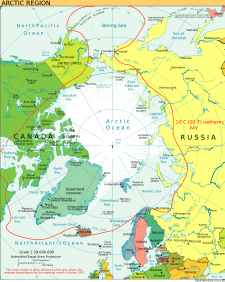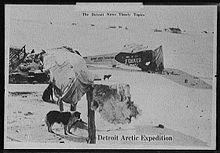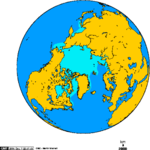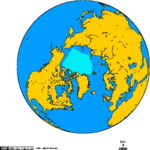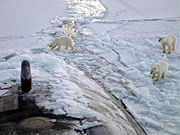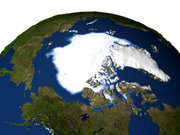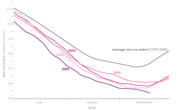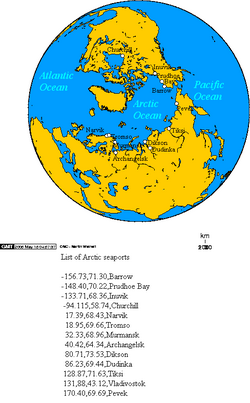Arctic Ocean
2008/9 Schools Wikipedia Selection. Related subjects: Geography
| Earth's oceans ( World Ocean) |
|---|
The Arctic Ocean, located in the northern hemisphere and mostly in the Arctic north polar region, is the smallest and shallowest of the world's five major oceans. The International Hydrographic Organization (IHO) recognizes it as an ocean, although some oceanographers call it the Arctic Mediterranean Sea or simply the Arctic Sea, classifying it as one of the mediterranean seas of the Atlantic Ocean. Alternatively, the Arctic Ocean can be seen as the northernmost lobe of the all-encompassing World Ocean.
Almost completely surrounded by Eurasia and North America, the Arctic Ocean is largely covered by sea ice throughout the year. The Arctic Ocean's temperature and salinity vary seasonally as the ice cover melts and freezes; its salinity is the lowest on average of the five major oceans, due to low evaporation, heavy freshwater inflow from rivers and streams, and limited connection and outflow to surrounding oceanic waters with higher salinities. The summer shrinking of the ice has been quoted at 50 %. The National Snow and Ice Data Centre NSIDC use satellite data to provide a daily record of Arctic sea ice cover and the rate of melting compared to an average period and specific past years.
Geography
The Arctic Ocean occupies a roughly circular basin and covers an area of about 14,056,000 km² (5,440,000 sq mi), almost the size of Russia. The coastline length is 45,390 kilometers (28,203 miles). Nearly landlocked, it is surrounded by the land masses of Eurasia, North America, Greenland, and several islands. It includes Baffin Bay, Barents Sea, Beaufort Sea, Chukchi Sea, East Siberian Sea, Greenland Sea, Hudson Bay, Hudson Strait, Kara Sea, Laptev Sea, White Sea and other tributary bodies of water. It is connected to the Pacific Ocean by the Bering Strait and to the Atlantic Ocean through the Greenland Sea and Labrador Sea.
According to the International Hydrographic Organization, the limits of the Arctic Ocean proper are (see the map):
- A great circle line running from Cape Morris Jesup, the northernmost point of Greenland () to the northernmost point of Spitsbergen ( south of which line lies the Greenland Sea).
- Parallel 80° North to North East Land ( Nordaustlandet).
- The north shore of Nordaustlandet to its easternmost point, Cape Leigh Smith ().
- A line running from Cape Leigh Smith to Cape Kohlsaat, the easternmost point of Franz Josef Land (, south of which line lies the Barents Sea].
- A line running from Cape Kohlsaat to Cape Molotov ( Arctic Cape), the northernmost point of Komsomolets Island (, south of which line lies the Kara Sea).
- A line running from Arctic Cape to the northernmost point of Kotelni Island (, south of which line lies the Laptev Sea).
- A line running from the northernmost point of Kotelni Island to the northernmost point of Wrangel Island (, south of which line lies the East Siberian Sea).
- A line running from the northernmost point of Wrangel Island to Point Barrow, the northernmost point of Alaska (, south of which line lies the Chuckchi Sea).
- A line running from Point Barrow to Cape Land's End on Prince Patrick Island, Northwest Territories (, south of which line lies the Beaufort Sea).
- The northwest coast of Prince Patrick Island north to Cape Leopold M'Clintock, its northernmost point ().
- A line running from Cape Leopold M'Clintock to Cape Murray on Brock Island ().
- The northwest coast of Brock Island north to its northernmost point ().
- A line running from the northernmost point of Brock Island to Cape Mackay on Borden Island, its westernmost point ().
- The northwest coast of Borden Island north to Cape Malloch (, the northernmost point of the Northwest Territories).
- A line running from Cape Malloch to Cape Isachsen on Ellef Ringnes Island, Nunavut, its northwesternmost point ().
- A line running from Cape Isachsen to the northwesternmost point of Meighen Island ().
- A line running from the northwesternmost point of Meighen Island to Cape Stallworthy on Axel Heiberg Island, its northernmost point ().
- A line running from Cape Stallworthy to Cape Colgate on Ellesmere Island, its westernmost point ().
- The north coast of Ellesmere Island north to Cape Columbia, its northernmost point ().
- A line running from Cape Columbia to Cape Morris Jesup (south of which line lies the Lincoln Sea).
An underwater ridge, the Lomonosov Ridge, divides the deep sea North Polar Basin into two oceanic basins: the Eurasian Basin, which is between 4,000 and 4,500 meters (13,000 and 15,000 ft) deep, and the Amerasian Basin (sometimes called the North American, or Hyperborean Basin), which is about 4,000 meters (13,000 ft) deep. The bathymetry of the ocean bottom is marked by fault-block ridges, plains of the abyssal zone, ocean deeps, and basins. The average depth of the Arctic Ocean is 1,038 meters (3,407 ft). The deepest point is in the Eurasian Basin, at 5,450 meters (17,881 ft).
The two major basins are further subdivided by ridges into the Canada Basin (between Alaska/Canada and the Alpha Ridge), Makarov Basin (between the Alpha and Lomonosov Ridges), Fram Basin (between Lomonosov and Nansen-Gakkel ridges), and Nansen Basin ( Amundsen Basin) (between the Nansen-Gakkel Ridge and the continental shelf that includes the Franz Joseph Land).
The Arctic Ocean contains a major chokepoint in the southern Chukchi Sea, which provides northern access to the Pacific Ocean via the Bering Strait between North America and the Russian city of Arkhangelsk. The Arctic Ocean also provides the shortest marine link between the extremes of eastern and western Russia. There are several floating research stations in the Arctic, operated by the US and Russia.
The greatest inflow of water comes from the Atlantic by way of the Norwegian Current, which then flows along the Eurasian coast. Water also enters from the Pacific via the Bering Strait. The East Greenland Current carries the major outflow.
Ice covers most of the ocean surface year-round, causing subfreezing temperatures much of the time. The Arctic is a major source of very cold air that inevitably moves toward the equator, meeting with warmer air in the middle latitudes and causing rain and snow. Marine life abounds in open areas, especially the more southerly waters. The ocean's major ports are the cities of Murmansk, Arkhangelsk, Churchill and Prudhoe Bay.
The Arctic Ocean is encompassed by the Arctic shelves, one of which, the Siberian Shelf, is the largest on Earth.
History
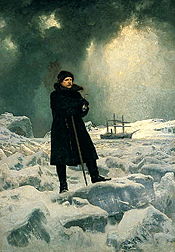
For much of European history, the geography of the North Polar regions remained largely unexplored and conjectural. Pytheas of Massalia recorded an account of a journey northward in 325 BCE, to a land he called " Eschate Thule," where the Sun only set for three hours each day and the water was replaced by a congealed substance "on which one can neither walk nor sail." He was probably describing loose sea ice known today as " growlers" and " bergy bits." His "Thule" may have been Iceland, though Norway is more often suggested.
Early cartographers were unsure whether to draw the region around the North Pole as land (as in Johannes Ruysch's map of 1507, or Gerardus Mercator's map of 1595) or water (as with Martin Waldseemüller's world map of 1507). The fervent desire of Europeans for a northern passage to " Cathay" (China) caused water to win out, and by 1723 mapmakers such as Johann Homann featured an extensive "Oceanus Septentrionalis" at the northern edge of their charts. The few expeditions to penetrate much beyond the Arctic Circle in this era added only small islands, such as Nova Zemlya (11th century) and Spitsbergen (1596), though since these were often surrounded by pack-ice their northern limits were not so clear. The makers of navigational charts, more conservative than some of the more fanciful cartographers, tended to leave the region blank, with only the bits of known coastline sketched in.
This lack of knowledge of what lay north of the shifting barrier of ice gave rise to a number of conjectures. In England and other European nations, the myth of an "Open Polar Sea" was long-lived and persistent. John Barrow, longtime Second Secretary of the British Admiralty, made this belief the cornerstone of his campaign of Arctic exploration from 1818 to 1845. In the United States in the 1850s and '60s, the explorers Elisha Kent Kane and Isaac Israel Hayes both claimed to have seen the outskirts of this elusive body of water. Even quite late in the century, the eminent authority Matthew Fontaine Maury included a description of the Open Polar Sea in his textbook The Physical Geography of the Sea (1883). Nevertheless, as all the explorers who trekked closer and closer to the pole reported, the polar ice cap was ultimately quite thick, and persists year-round.
Fridtjof Nansen was the first to make a nautical crossing of the Arctic Ocean, in 1896. The first surface crossing of the ocean was led by Wally Herbert in 1969, in a dog sled expedition from Alaska to Svalbard with air support.
Since 1937, Soviet and Russian manned drifting ice stations extensively monitored the Arctic Ocean. Scientific settlements were established on the drift ice and carried thousands of kilometers by ice floes.
Climate
| The images compare late summer and late winter ice cover, averaged between the years 1978 and 2002. | |
Under the influence of the present ice age, the ocean is contained in a polar climate characterized by persistent cold and relatively narrow annual temperature ranges. Winters are characterized by continuous darkness, cold and stable weather conditions, and clear skies; summers are characterized by continuous daylight, damp and foggy weather, and weak cyclones with rain or snow.
The temperature of the surface of the Arctic Ocean is fairly constant, near the freezing point of seawater, slightly below zero degrees Celsius. In the winter the relatively warm ocean water exerts a moderating influence, even when covered by ice. This is one reason why the Arctic does not experience the extremes of temperature seen on the Antarctic continent.
There is considerable seasonal variation in how much pack ice of the Arctic ice pack covers the Arctic Ocean. Much of the ocean is also covered in snow for about 10 months of the year. The maximum snow cover is in March or April — about 20 to 50 centimeters (8 to 20 inches) over the frozen ocean.
Climate has varied significantly in the past; as recently as 55 million years ago, during the Paleocene–Eocene Thermal Maximum the region reached an average annual temperature of 10-20 °C; the surface waters of the northernmost Arctic ocean warmed, seasonally at least, enough to support tropical lifeforms requiring surface temperatures of over 22°C.
Natural hazards
Ice islands occasionally break away from northern Ellesmere Island, and icebergs are formed from glaciers in western Greenland and extreme northeastern Canada. Permafrost is found on most islands. The ocean is virtually icelocked from October to June, and ships are subject to superstructure icing from October to May. Before the advent of modern icebreakers, ships sailing the Arctic Ocean risked being trapped or crushed by sea ice. Interestingly, two " ghost ships", the Baychimo and the Octavius, drifted through the Arctic Ocean untended for decades despite these hazards.
Animal and plant life
Endangered marine species include walruses and whales. The area has a fragile ecosystem which is slow to change and slow to recover from disruptions or damage.
The Arctic Ocean has relatively little plant life except for phytoplankton. Phytoplankton are a crucial part of the ocean and there are massive amounts of them in the Arctic. Nutrients from rivers and the currents of the Atlantic and Pacific oceans provide food for the Arctic phytoplankton. During summer, the Sun is out day and night, thus enabling the phytoplankton to photosynthesize for long periods of time and reproduce quickly. However, the reverse is true in winter where they struggle to get enough light to survive.
Environmental concerns
The polar ice pack is thinning, and there is a seasonal hole in ozone layer in many years. Reduction of the area of Arctic sea ice will have an effect on the planet's albedo, thus possibly affecting global warming within a positive feedback mechanism. Many scientists are presently concerned that warming temperatures in the Arctic may cause large amounts of fresh meltwater to enter the North Atlantic, possibly disrupting global ocean current patterns. Potentially severe changes in the Earth's climate might then ensue.
Other environmental concerns relate to the radioactive contamination of the Arctic Ocean from, for example, Russian radioactive waste dumpsites in the Kara Sea and Cold War nuclear test sites such as Novaya Zemlya.
Major ports and harbors
- Churchill, Manitoba, Canada
- Inuvik, Canada
- Prudhoe Bay, Alaska, United States
- Barrow, Alaska, United States
- Pevek, Russia
- Tiksi, Russia
- Dikson, Russia
- Dudinka, Russia
- Murmansk, Russia
- Arkhangelsk, Russia
- Kirkenes, Norway
- Vardø, Norway
- Longyearbyen, Spitsbergen, Norway
